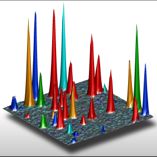2016/01/22
In a recent study Lukasz Piatkowski and Esther Gellings in the Molecular NanoPhotonics group led by ICREA professor Niek van Hulst have developed a broadband excitation spectroscopy method to reveal extensive spectral heterogeneity of individual molecules under ambient conditions. The work was published in Nature Communications.
Single molecule spectroscopy at ambient conditions automatically implies emission spectroscopy, which so far has left excitation spectroscopy out of scope. Yet excitation spectroscopy gives access to the fs-ps-ns dynamics in the electronic excited state. The excited state gives way to a variety of decay channels, such as energy transfer, non-radiative decay, photo-dissociation, inter-system-crossing and of course fluorescence. As such, excited state dynamics is very sensitive to interactions with the local environment. Instead, the well-established emission spectroscopy has its source in spontaneous decay from the final ns electronic state and is missing out all ultrafast dynamics. Clearly, only the combination of both, excitation and emission techniques, would yield a full picture of the photophysical properties of individual molecules and their interactions with the surroundings.
The ICFO researchers have presented a novel approach based on interferometric broadband excitation combined with confocal fluorescence detection, bringing single molecule excitation spectroscopy side-by-side to single molecule emission spectroscopy. The broadband interferometric approach is resilient against blinking and bleaching as the entire excitation spectrum is probed at once. Unprecedented spectral heterogeneities of single molecules, with individual excitation spectra shifted in wavelength by more than 100 nm are revealed. Conventional narrowband excitation techniques would be incapable to capture the whole extent of the spectral distribution and would miss out on molecules detected by the broadband scheme.
Niek van Hulst research group
Link to the paper

Single molecules show their colours

Exciting molecules of different colours











